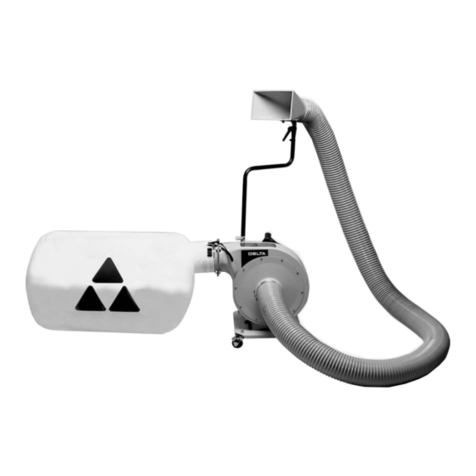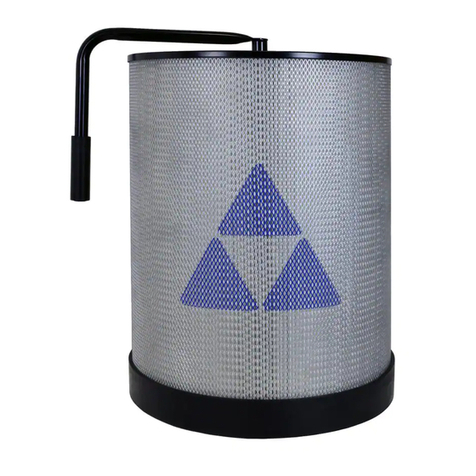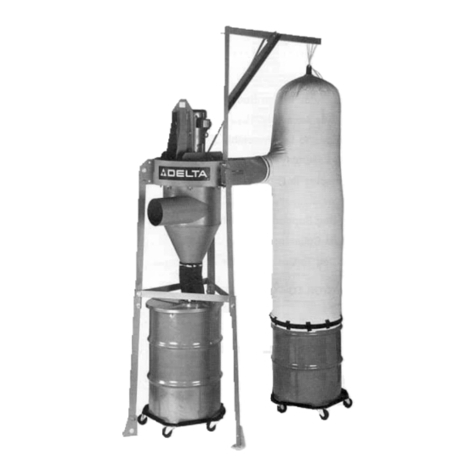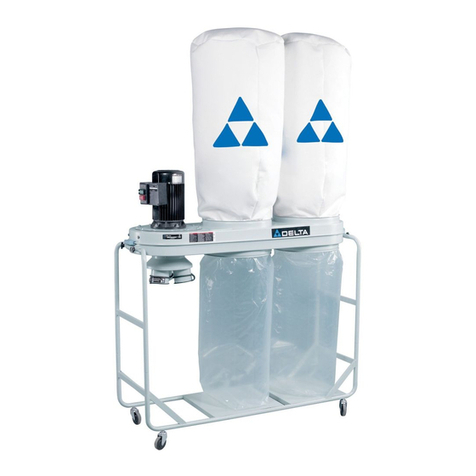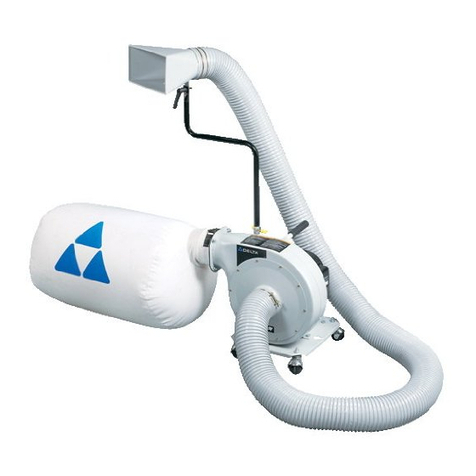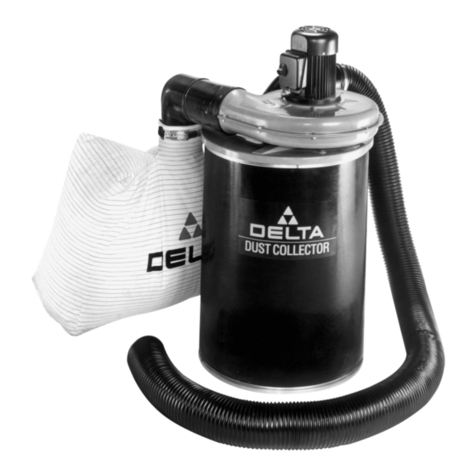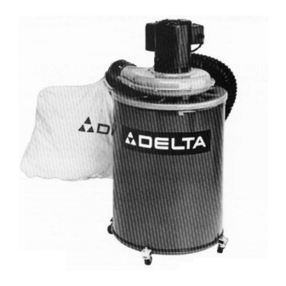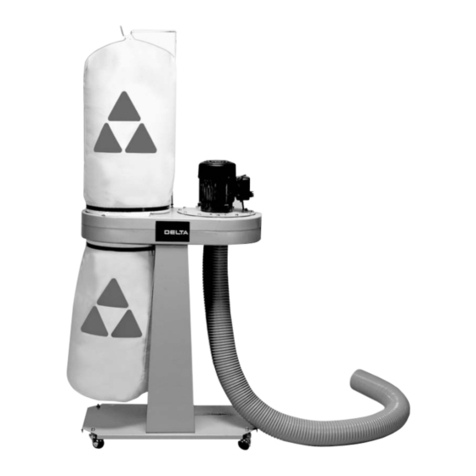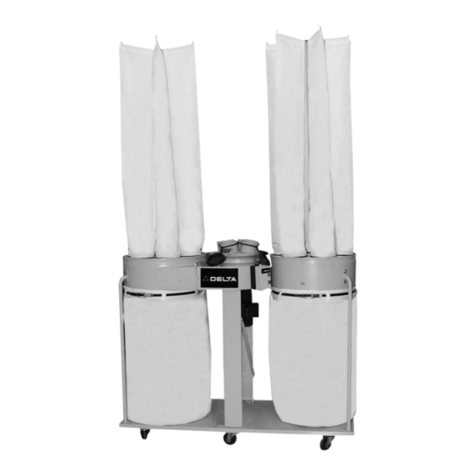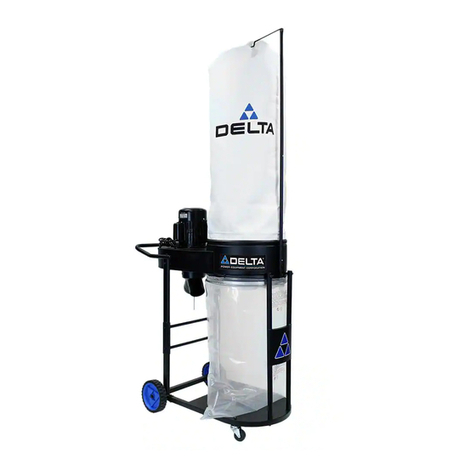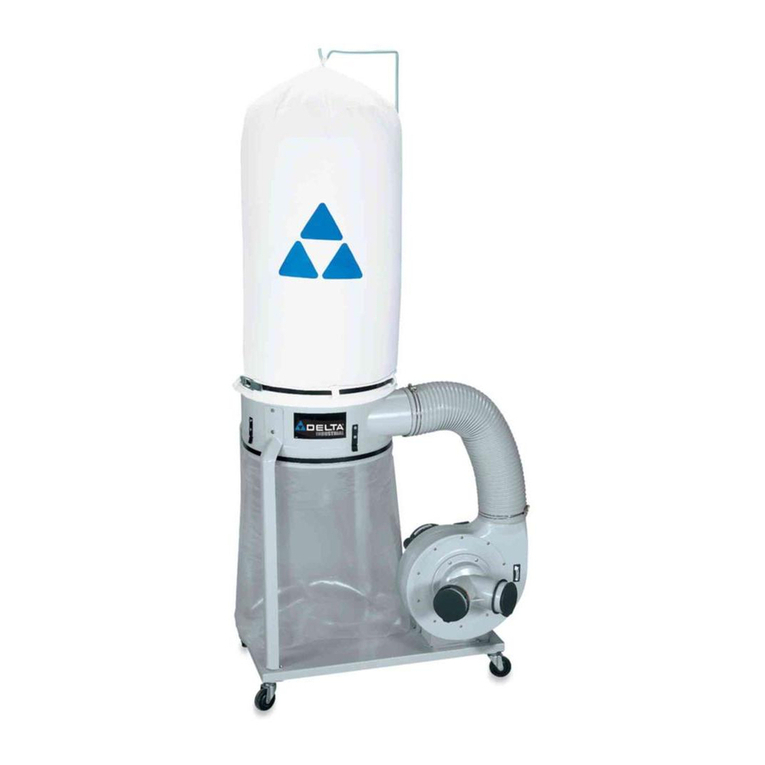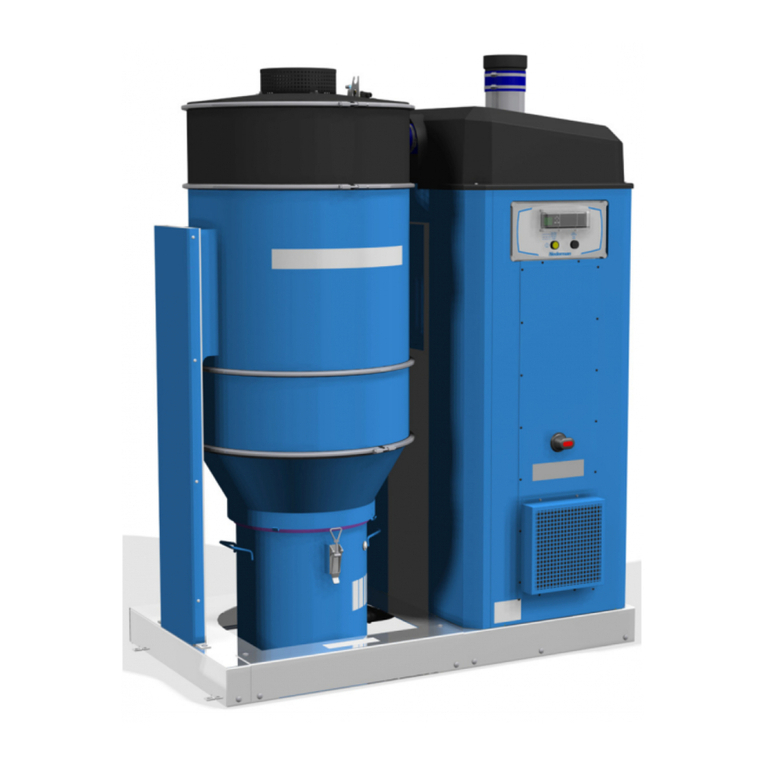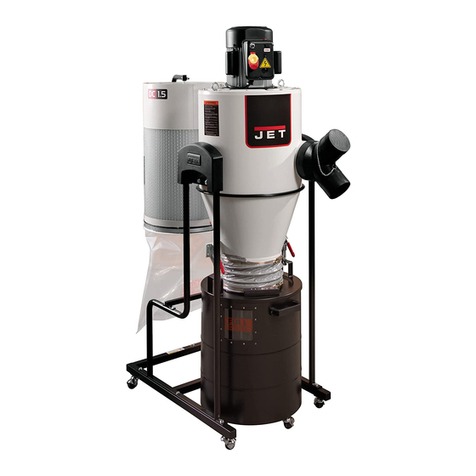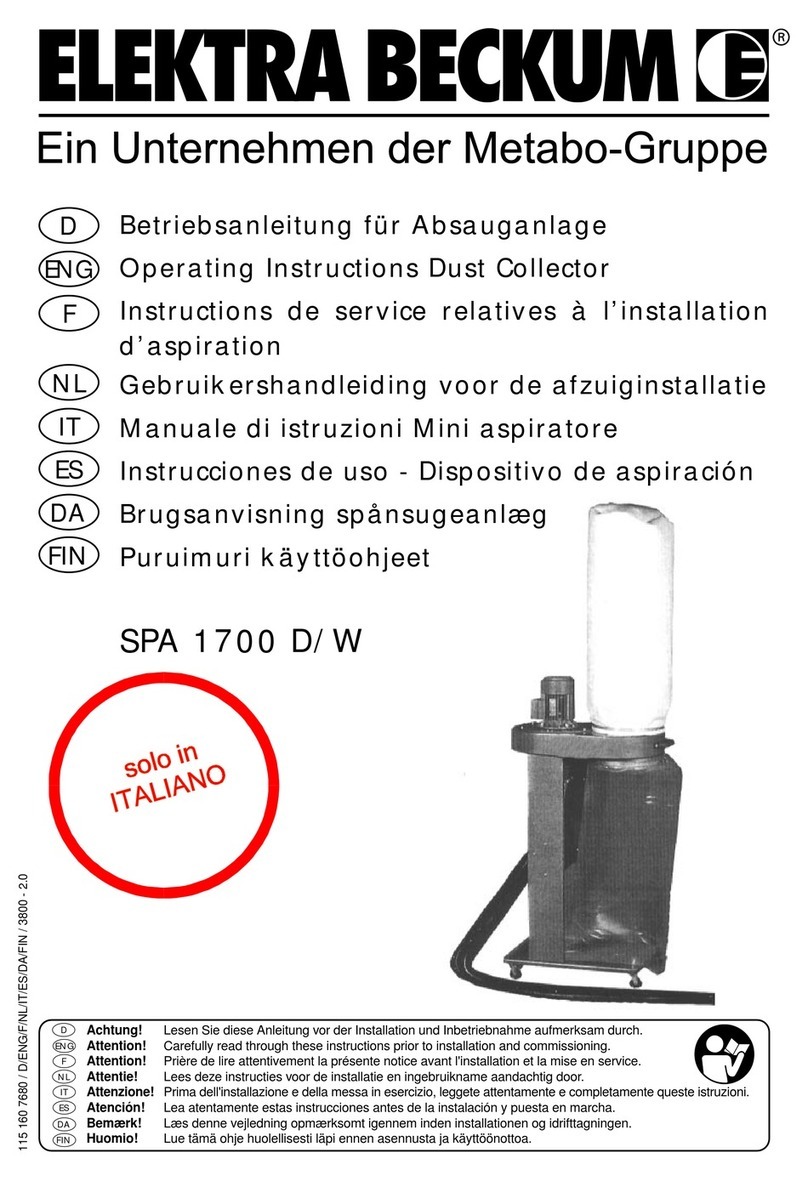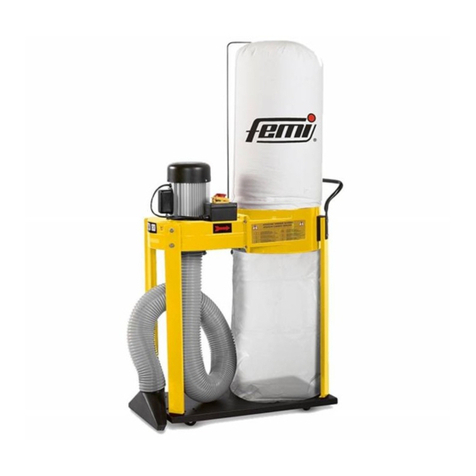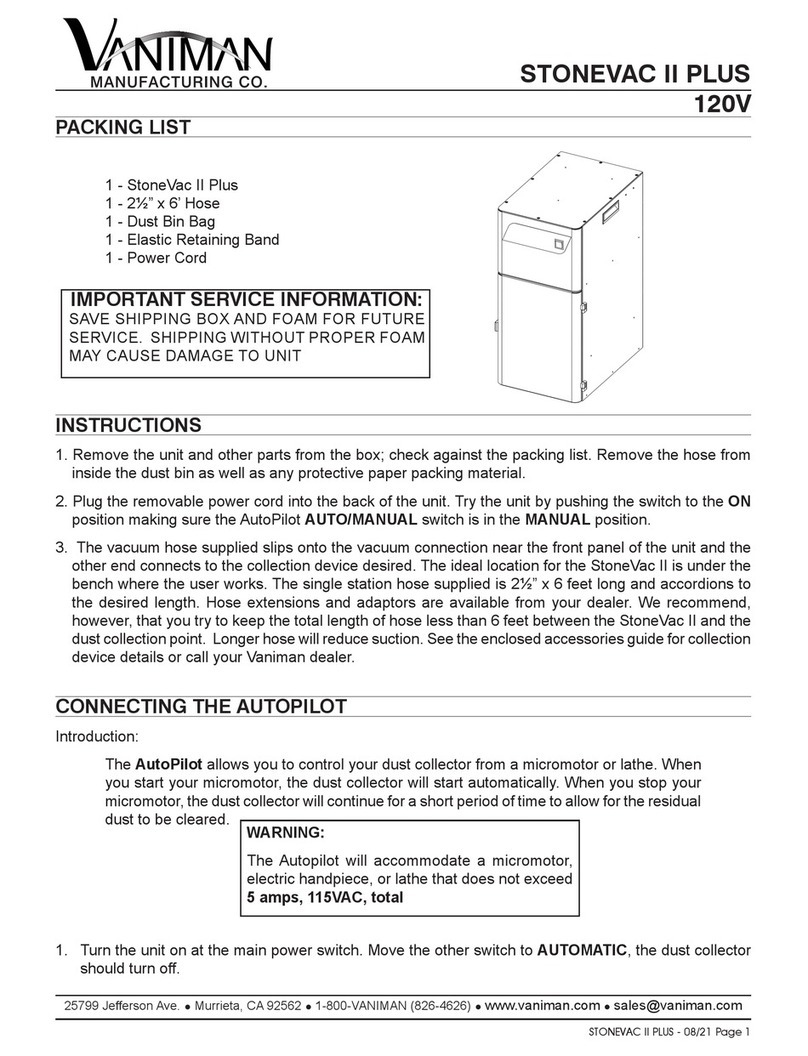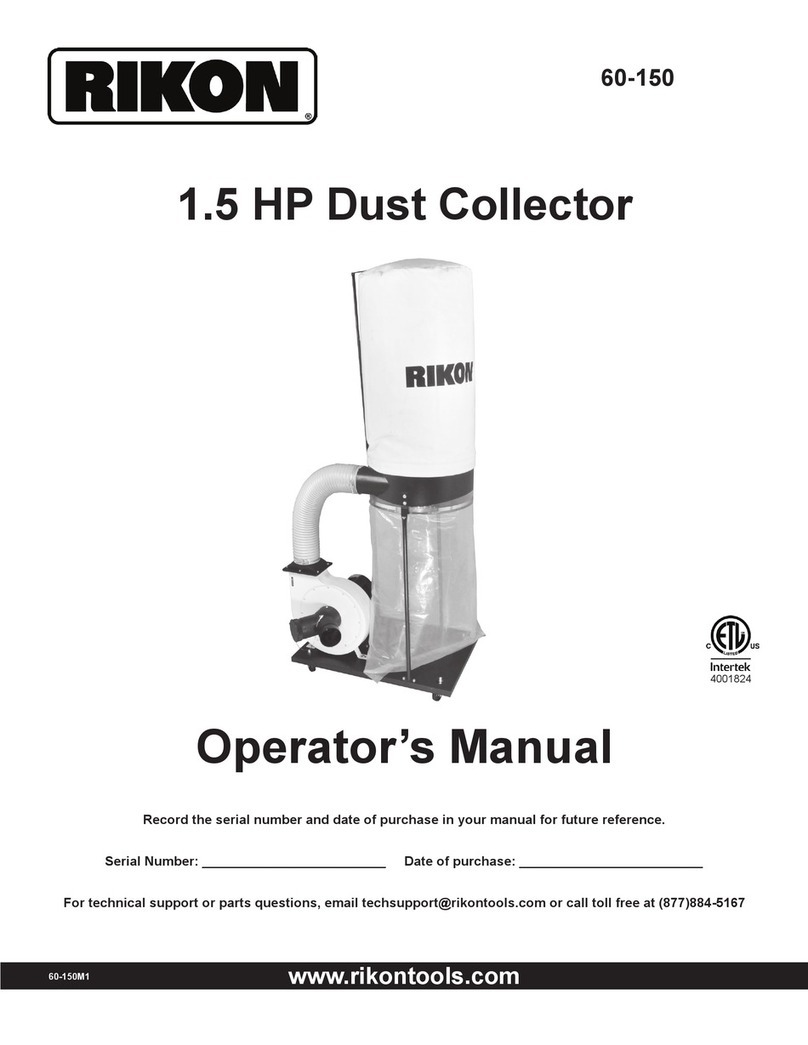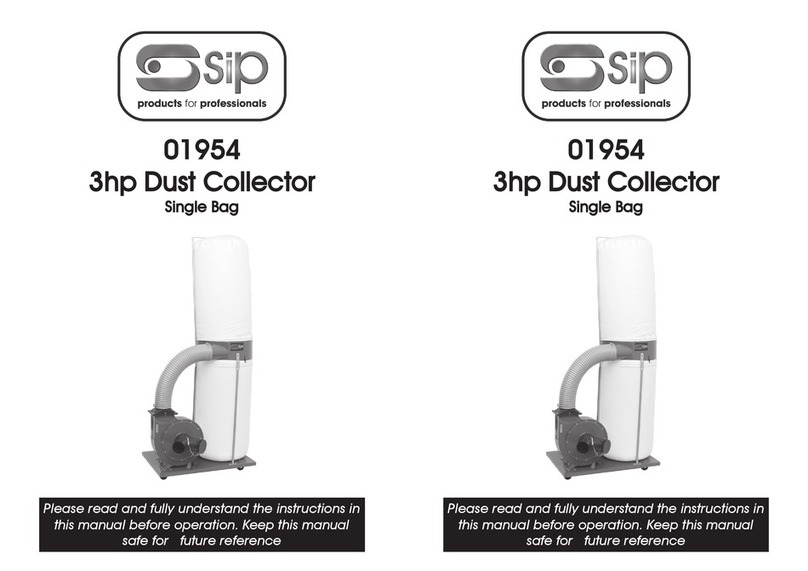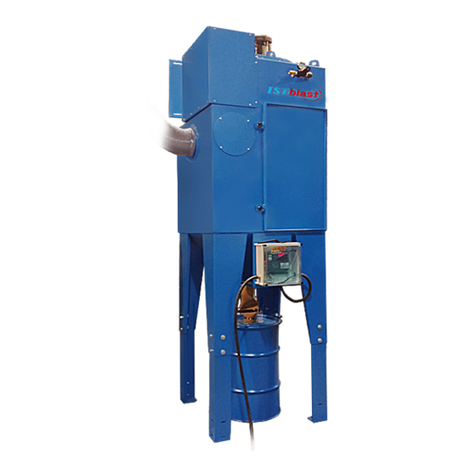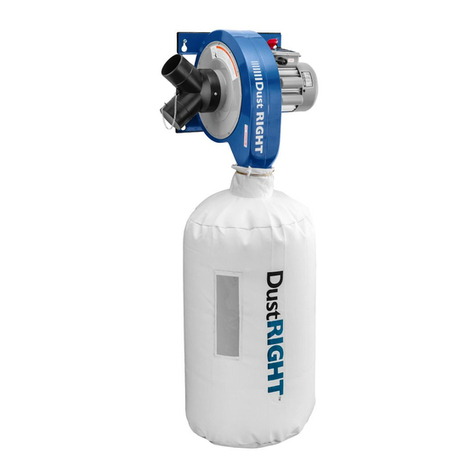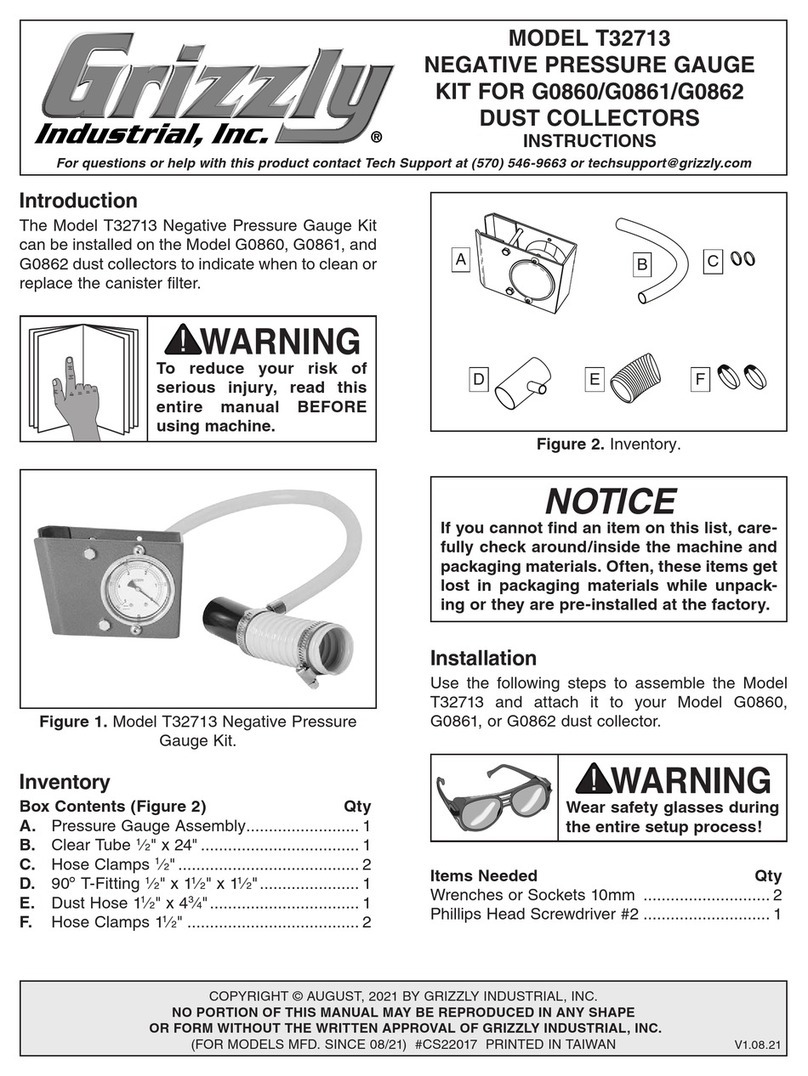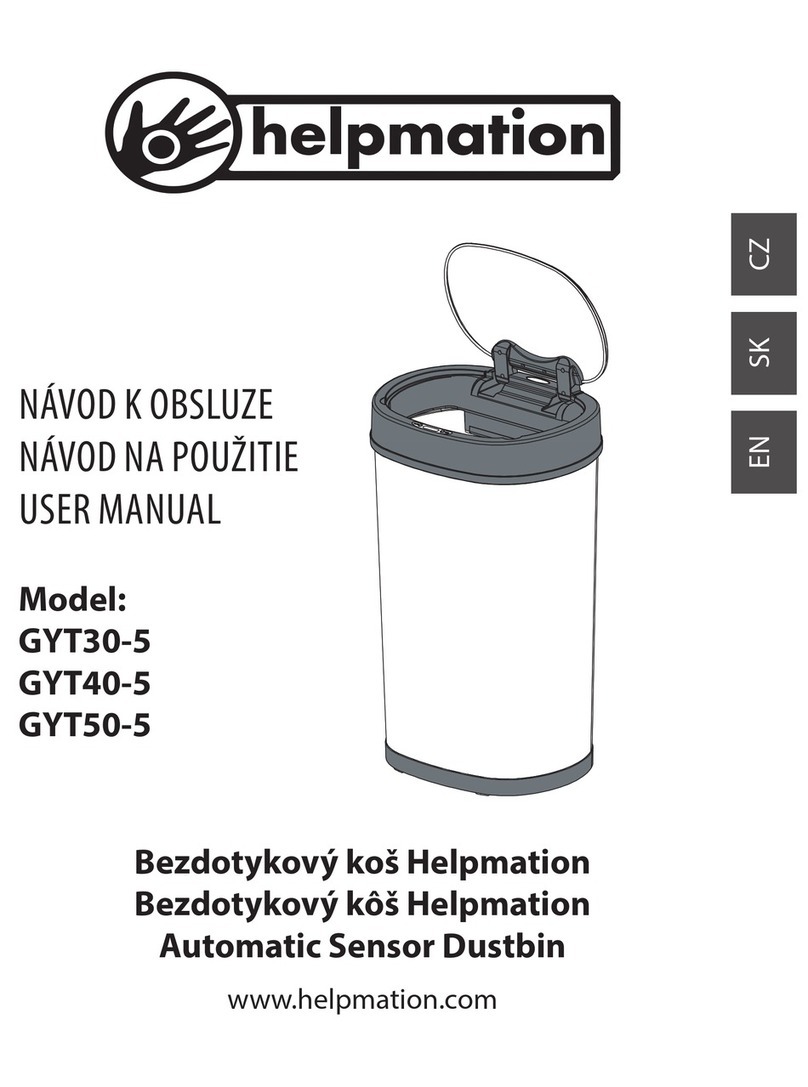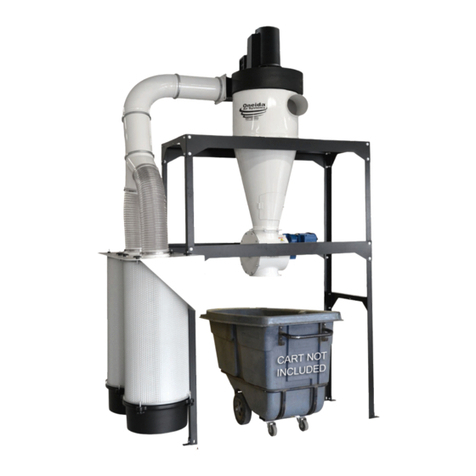Delta 50-720 User manual

Colector de polvo
monoetápico de un H.P.
Dépoussiéreur à étage
unique de 1 HP
Instruction manual
Manuel d’utilisation
Manual de instrucciones
www.deltaportercable.com
50-720
50-720CT
Français (13)
Español (24)
ONE H.P. SINGLE-STAGE
DUST COLLECTOR
INSTRUCTIVO DE OPERACIÓN, CENTROS
DE SERVICIO Y PÓLIZA DE GARANTÍA.
LÉASE ESTE INSTRUCTIVO
ANTES DE USAR EL PRODUCTO.
(20901)
RTD10000570AA

2
TABLE OF CONTENTS
IMPORTANT SAFETY INSTRUCTIONS
Read and understand all warnings and operating instructions before using any tool
or equipment. When using tools or equipment, basic safety precautions should always be followed
to reduce the risk of personal injury. Improper operation, maintenance or modification of tools or
equipment could result in serious injury and property damage. There are certain applications for which
tools and equipment are designed. Delta Machinery strongly recommends that this product NOT be modified and/or
used for any application other than for which it was designed.
SAFETY GUIDELINES - DEFINITIONS
Some dust created by power sanding, sawing, grinding, drilling, and other construction activities
contains chemicals known to the State of California to cause cancer, birth defects or other reproductive harm.
Some examples of these chemicals are:
s LEADFROMLEADBASEDPAINTS
s CRYSTALLINESILICAFROMBRICKSANDCEMENTANDOTHERMASONRYPRODUCTSAND
s ARSENICANDCHROMIUMFROMCHEMICALLYTREATEDLUMBER
Your risk from these exposures varies, depending on how often you do this type of work. To reduce your
exposure to these chemicals: work in a well ventilated area, and work with approved safety equipment, always
wear NIOSH/OSHA approved, properly fitting face mask or respirator when using such tools.
IMPORTANT SAFETY INSTRUCTIONS ....................2
SAFETY GUIDELINES - DEFINITIONS .....................2
GENERAL SAFETY RULES .......................................3
ADDITIONAL SPECIFIC SAFETY RULES ................4
FUNCTIONAL DESCRIPTION ..................................6
CARTON CONTENTS ...............................................6
ASSEMBLY .................................................................7
OPERATION ...............................................................10
If you have any questions relative to its application DO NOT use the product until you have written Delta Machinery and
we have advised you. Contact us online at www.deltaportercable.com or by mail at Technical Service Manager, Delta
Machinery, 4825 Highway 45 North, Jackson, TN 38305. In Canada,125 Mural St. Suite 300, Richmond Hill, ON, L4B 1M4)
Information regarding the safe and proper operation of this tool is available from the following sources:
s 0OWER4OOL)NSTITUTE1300 Sumner Avenue, Cleveland, OH 44115-2851or online at www.powertoolinstitute.org
s .ATIONAL3AFETY#OUNCIL 1121 Spring Lake Drive, Itasca, IL 60143-3201
s !MERICAN.ATIONAL3TANDARDS)NSTITUTE 25 West 43rd Street, 4 floor, New York, NY 10036 www.ansi.org - ANSI 01.1
Safety Requirements for Woodworking Machines
s 53$EPARTMENTOF,ABOR regulations www.osha.gov
SAVE THESE INSTRUCTIONS!
TROUBLESHOOTING................................................11
MAINTENANCE..........................................................11
SERVICE.....................................................................11
ACCESSORIES...........................................................12
WARRANTY................................................................12
FRANÇAIS .................................................................13
ESPAÑOL....................................................................24
It is important for you to read and understand this manual. The information it contains relates to protecting YOUR SAFETY
and PREVENTING PROBLEMS. The symbols below are used to help you recognize this information.
Indicates an imminently hazardous situation which, if not avoided, will result in death or serious
injury.
Indicates a potentially hazardous situation which, if not avoided, could result in death or serious
injury.
Indicates a potentially hazardous situation which, if not avoided, may result in minor or moderate
injury.
Used without the safety alert symbol indicates a potentially hazardous situation which, if not avoided,
may result in property damage.

3
1. FOR YOUR OWN SAFETY, READ THE INSTRUCTION
MANUAL BEFORE OPERATING THE MACHINE. Learning
the machine’s application, limitations, and specific hazards
will greatly minimize the possibility of accidents and injury.
2. WEAR EYE AND HEARING PROTECTION. ALWAYS
USE SAFETY GLASSES. Everyday eyeglasses are NOT
safety glasses. USE CERTIFIED SAFETY EQUIPMENT.
Eye protection equipment should comply with ANSI Z87.1
standards. Hearing equipment should comply with ANSI
S3.19 standards.
3. WEAR PROPER APPAREL. Do not wear loose clothing,
gloves, neckties, rings, bracelets, or other jewelry which may
get caught in moving parts. Nonslip protective footwear is
recommended. Wear protective hair covering to contain long
hair.
4. DO NOT USE THE MACHINE IN A DANGEROUS
ENVIRONMENT. The use of power tools in damp or wet
locations or in rain can cause shock or electrocution. Keep
your work area well-lit to prevent tripping or placing arms,
hands, and fingers in danger.
5. MAINTAIN ALL TOOLS AND MACHINES IN PEAK
CONDITION. Keep tools sharp and clean for best and safest
performance. Follow instructions for lubricating and changing
accessories. Poorly maintained tools and machines can further
damage the tool or machine and/or cause injury.
6. CHECK FOR DAMAGED PARTS. Before using the machine,
check for any damaged parts. Check for alignment of moving
parts, binding of moving parts, breakage of parts, and any
other conditions that may affect its operation. A guard or any
other part that is damaged should be properly repaired or
replaced with Delta or factory authorized replacement
parts. Damaged parts can cause further damage to the
machine and/or injury.
7. KEEP THE WORK AREA CLEAN. Cluttered areas and benches
invite accidents.
8. KEEP CHILDREN AND VISITORS AWAY. Your shop is a
potentially dangerous environment. Children and visitors can be
injured.
9. REDUCE THE RISK OF UNINTENTIONAL STARTING. Make
sure that the switch is in the “OFF” position before plugging
in the power cord. In the event of a power failure, move the
switch to the “OFF” position. An accidental start-up can cause
injury. Do not touch the plug’s metal prongs when unplugging
or plugging in the cord.
10. USE THE GUARDS. Check to see that all guards are in place,
secured, and working correctly to prevent injury.
11. REMOVE ADJUSTING KEYS AND WRENCHES BEFORE
STARTING THE MACHINE. Tools, scrap pieces, and other
debris can be thrown at high speed, causing injury.
12. USE THE RIGHT MACHINE. Don’t force a machine or an
attachment to do a job for which it was not designed. Damage
to the machine and/or injury may result.
13. USE RECOMMENDED ACCESSORIES. The use of
accessories and attachments not recommended by Delta
may cause damage to the machine or injury to the user.
14. USE THE PROPER EXTENSION CORD. Make sure your
extension cord is in good condition. When using an extension
cord, be sure to use one heavy enough to carry the current
your product will draw. An undersized cord will cause a drop
in line voltage, resulting in loss of power and overheating. See
the Extension Cord Chart for the correct size depending on
the cord length and nameplate ampere rating. If in doubt, use
the next heavier gauge. The smaller the gauge number, the
heavier the cord.
15. SECURE THE WORKPIECE. Use clamps or a vise to hold the
workpiece when practical. Loss of control of a workpiece can
cause injury.
16. FEED THE WORKPIECE AGAINST THE DIRECTION OF
THE ROTATION OF THE BLADE, CUTTER, OR ABRASIVE
SURFACE. Feeding it from the other direction will cause the
workpiece to be thrown out at high speed.
17. DON’T FORCE THE WORKPIECE ON THE MACHINE.
Damage to the machine and/or injury may result.
18. DON’T OVERREACH. Loss of balance can make you fall into
a working machine, causing injury.
19. NEVER STAND ON THE MACHINE. Injury could occur if the tool
tips, or if you accidentally contact the cutting tool.
20. NEVER LEAVE THE MACHINE RUNNING UNATTENDED.
TURN THE POWER OFF. Don’t leave the machine until it comes
to a complete stop. A child or visitor could be injured.
21. TURN THE MACHINE “OFF”, AND DISCONNECT THE
MACHINE FROM THE POWER SOURCE before installing or
removing accessories, changing cutters, adjusting or changing
set-ups. When making repairs, be sure to lock the start switch
in the “OFF” position. An accidental start-up can cause injury.
22. MAKE YOUR WORKSHOP CHILDPROOF WITH
PADLOCKS, MASTER SWITCHES, OR BY REMOVING
STARTER KEYS. The accidental start-up of a machine by a
child or visitor could cause injury.
23. STAY ALERT, WATCH WHAT YOU ARE DOING, AND USE
COMMON SENSE. DO NOT USE THE MACHINE WHEN
YOU ARE TIRED OR UNDER THE INFLUENCE OF DRUGS,
ALCOHOL, OR MEDICATION. A moment of inattention while
operating power tools may result in injury.
24. USE OF THIS TOOL CAN GENERATE AND
DISBURSE DUST OR OTHER AIRBORNE PARTICLES,
INCLUDING WOOD DUST, CRYSTALLINE SILICA DUST
AND ASBESTOS DUST. Direct particles away from face
and body. Always operate tool in well ventilated area and
provide for proper dust removal. Use dust collection system
wherever possible. Exposure to the dust may cause serious
and permanent respiratory or other injury, including silicosis (a
serious lung disease), cancer, and death. Avoid breathing the
dust, and avoid prolonged contact with dust. Allowing dust to
get into your mouth or eyes, or lay on your skin may promote
absorption of harmful material. Always use properly fitting
NIOSH/OSHA approved respiratory protection appropriate for
the dust exposure, and wash exposed areas with soap and
water.
GENERAL SAFETY RULES
Failure to follow these rules may result in serious personal injury.

4
1. DO NOT OPERATE THIS UNIT UNTIL IT IS COMPLETE-
LY ASSEMBLED AND INSTALLED ACCORDING TO
THE INSTRUCTIONS. A unit incorrectly assembled can
cause injury.
2. OBTAIN ADVICE FROM YOUR SUPERVISOR, IN-
STRUCTOR, OR ANOTHER QUALIFIED PERSON if
you are not thoroughly familiar with the operation of this
unit. Knowledge is safety
3. FOLLOW ALL WIRING CODES and recommended
electrical connections to prevent electrical shock or
electrocution.
4. DO NOT PULL THIS UNIT BY THE POWER CORD. Do
not allow the power cord to come in contact with sharp
instruments or edges, hot surfaces, or oil or grease.
Do not place any weight on top of the power cord. A
damaged power cord can cause electrical shock or
electrocution.
5. SUPPORT THIS UNIT OR SECURELY CLAMP IT
TO THE WORK SURFACE WHEN IT IS USED IN A
PORTABLE APPLICATION to eliminate potential injury
and/or damage from falling.
6. ENSURE THAT THE INTAKE AND EXHAUST AREAS
ARE CLEAR PRIOR TO STARTING THE UNIT. Clogged
intakes or exhausts can cause an explosion and/or fire.
7. DO NOT USE THE DUST COLLECTOR to pick up
flammable liquids such as gasoline. Do not use the
dust collector near flammable or combustible liquids.
Explosion and/or fire can occur.
8. KEEP ARMS, HANDS, AND FINGERS AWAY FROM
THE FAN. Avoid all exposure to rotating parts to prevent
injury.
9. DO NOT OPERATE THIS UNIT WITHOUT THE DUST
COLLECTION BAG IN PLACE AND PROPERLY SECURED.
Sawdust and other debris can provide the potential for fire
and/or explosion and can also cause inhalation problems.
10. INSPECT THE DUST BAG FOR CUTS, RIPS, OR
TEARS. Replace damaged bags or vacuum hoses.
Sawdust and other debris can provide the potential for fire
and/or explosion and can also cause inhalation problems.
11. ALWAYS USE THE INTAKE CAPS TO COVER UNUSED
DUST PORTS. Debris can cause damage to the unit and
injury.
12. DO NOT ATTEMPT TO REMOVE OR REPLACE the
dust collection bag(s) while the unit is connected to
the power source. Exposed fan blades can cause severe
injuries.
13. MAINTAIN THE UNIT IN TOP CONDITION. Clogged
filters can increase the potential for fire or explosion.
Follow all instructions for changing and cleaning filters.
14. STORE THIS UNIT IN A LOCATION that eliminates the
potential for damage to the power cord. A damaged
power cord can cause shock or electrocution. Safely
store power cord on the unit to eliminate tripping
hazards.
15. TURN THE UNIT “OFF” AND DISCONNECT THE UNIT
from the power source before installing or removing
accessories, before adjusting or changing set-ups, or
when making repairs. An accidental start-up can cause
serious injury.
16. TURN THE UNIT “OFF”, disconnect the unit from the
power source, and clean the table/work area before
leaving the area.
17. Ground your dust collector along all plastic components.
The connection of bare 12 gauge copper wire on all
plastic hoses, fittings, and blast gates to all machines will
help reduce static build up and discharge.
Failure to follow these rules may result in serious personal injury.
ADDITIONAL SPECIFIC SAFETY RULES
POWER CONNECTIONS
A separate electrical circuit should be used for your machines. This circuit should not be less than #12 wire and should
be protected with a 20 Amp time lag fuse. If an extension cord is used, use only 3-wire extension cords which have
3-prong grounding type plugs and matching receptacle which will accept the machine’s plug. Before connecting the
machine to the power line, make sure the switch (s) is in the “OFF” position and be sure that the electric current is of
the same characteristics as indicated on the machine. All line connections should make good contact. Running on low
voltage will damage the machine.
Do not expose the machine to rain or operate the machine in damp locations.
MOTOR SPECIFICATIONS
Your machine is wired for 120 volts 60 HZ alternating current. Before connecting the machine to the power source, make
sure the switch is in the “OFF” position.
GROUNDING INSTRUCTIONS
This machine must be grounded while in use to protect the operator from electric shock.
DO NOT USE THIS UNIT TO DISSIPATE FUMES OR SMOKE. Explosions or fire can result. This dust collector is intended for
use where only dry airborne dust is present. Its use should be limited to non-explosive, non-metallic atmospheres.
DO NOT USE THIS UNIT TO FILTER METAL DUST. Combining wood and metal dust can create an explosion or fire
hazard. This unit is intended to filter non-explosive atmospheres only.

5
Fig. A Fig. B
GROUNDED OUTLET BOX
CURRENT
CARRYING
PRONGS
GROUNDING BLADE
IS LONGEST OF THE 3 BLADES
GROUNDED OUTLET BOX
GROUNDING MEANS
ADAPTER
1. All grounded, cord-connected machines:
In the event of a malfunction or breakdown, grounding provides a path of least resistance for electric current to
reduce the risk of electric shock. This machine is equipped with an electric cord having an equipment-grounding
conductor and a grounding plug. The plug must be plugged into a matching outlet that is properly installed and
grounded in accordance with all local codes and ordinances.
Do not modify the plug provided - if it will not fit the outlet, have the proper outlet installed by a qualified electrician.
Improper connection of the equipment-grounding conduc-tor can result in risk of electric shock. The conductor
with insulation having an outer surface that is green with or without yellow stripes is the equipment-grounding
conductor. If repair or replacement of the electric cord or plug is necessary, do not connect the equipment-
grounding conductor to a live terminal.
Check with a qualified electrician or service personnel if the grounding instructions are not completely
understood, or if in doubt as to whether the machine is properly grounded.
Use only 3-wire extension cords that have 3-prong grounding type plugs and matching 3-conductor receptacles that
accept the machine’s plug, as shown in Fig. A.
Repair or replace damaged or worn cord immediately.
2. Grounded, cord-connected machines intended for use on a supply circuit having a nominal rating less
than 150 volts:
If the machine is intended for use on a circuit that has an outlet that looks like the one illustrated in Fig. A,the
machine will have a grounding plug that looks like the plug illustrated in Fig. A.A temporary adapter, which looks
like the adapter illustrated in Fig. B, may be used to connect this plug to a matching 2-conductor receptacle as
shown in Fig. B if a properly grounded outlet is not available. The temporary adapter should be used only until
a properly grounded outlet can be installed by a qualified electrician. The green-colored rigid ear, lug, and the
like, extending from the adapter must be connected to a permanent ground such as a properly grounded outlet
box. Whenever the adapter is used, it must be held in place with a metal screw.
NOTE: In Canada, the use of a temporary adapter is not permitted by the Canadian Electric Code.
In all cases, make certain that the receptacle in question is properly grounded. If you are not sure,
have a qualified electrician check the receptacle.
EXTENSION CORDS
Use proper extension cords. Make
sure your extension cord is in good condition and is a
3-wire extension cord which has a 3-prong grounding
type plug and matching receptacle which will accept
the machine’s plug. When using an extension cord,
be sure to use one heavy enough to carry the current
of the machine. An undersized cord will cause a
drop in line voltage, resulting in loss of power and
overheating. Fig. D-1 shows the correct gauge to use
depending on the cord length. If in doubt, use the
next heavier gauge. The smaller the gauge number,
the heavier the cord.
MINIMUM GAUGE EXTENSION CORD
RECOMMENDED SIZES FOR USE WITH STATIONARY ELECTRIC MACHINES
Ampere
Rating Volts
Total
Length of
Cord in
Feet Gauge of Extension
Cord
0-6 120
up to
25 18 AWG
0-6 120 25-50 16 AWG
0-6 120 50-100 16 AWG
0-6 120 100-150 14 AWG
6-10 120
up to
25 18 AWG
6-10 120 25-50 16 AWG
6-10 120 50-100 14 AWG
6-10 120 100-150 12 AWG
10-12 120
up to
25 16 AWG
10-12 120 25-50 16 AWG
10-12 120 50-100 14 AWG
10-12 120 100-150 12 AWG
12-16 120
up to
25 14 AWG
12-16 120 25-50 12 AWG
12-16 120 GREATER THAN 50 FEET NOT RECOMMENDED

6
1. Upper Filter Bag Hanger
2. Hose
3. Motor and Blower Assembly
4. Upper Filter Bag
5. Disposable Bottom Bag (6)
6. Base
7. Side Support (2)
8. Support
9. Curved Side Support (2)
10. Wheel Casters (4)
11. Hose clamp (2)
12. Bag Clamps (2)
13. 5/16-18 x 5/8" Hex-Head Bolt (24)
14. 5/16 Lockwasher (24)
15. 5/16-18 Hex nut (16)
FOREWORD
The Delta 50-720 will connect to woodworking machines that accept a 4" diameter hose. This model comes with one 1
micron collection bag, disposable clear plastic bottom bags, and a 4" x 5 ft. collection hose.
FUNCTIONAL DESCRIPTION
NOTICE: The photo on the manual cover illustrates the current production model. All other illustrations contained in the
manual are representative only and may not depict the actual labeling or accessories included. These are intended to
illustrate technique only.
CARTON CONTENTS
1
2
3
4
5
6 7 8
9
10 11
13
14
15
12
For Model 50-720 only

7
1. Place the dust collector base (A) Fig. 3 upright.
2. Align the two holes (B) in the side support (end with the Delta logo) with the two holes in the base.
3. Insert a 5/16-18 x 5/8" hex head bolt (B) Fig. 3 through each hole in the side support and base (A).
4. Place a 5/16" lockwasher on the hex-head bolt.
5. Thread a 5/16-18 hex nut on the hex-head bolt and tighten securely.
6. Repeat this process for the remaining side support.
7. Use four 5/16-18 x 5/8" hex head screws, lockwashers and nuts to secure
the side supports (B) Fig. 4 and curved side supports (A) together.
ASSEMBLY TOOLS REQUIRED
12mm and 13mm Wrench, Open-End or Socket.
ASSEMBLY TIME ESTIMATE
Assembly for this machine takes approximately 1-2 hours.
Each of the casters is embedded with a bolt (A) Fig. 1. Screw the bolt end of each caster into the tapped holes on the
bottom of the base (Fig. 2) . Tighten each one securely.
Fig. 1
A
ASSEMBLY
For your own safety, do not connect the machine to the power source until the machine is
completely assembled and you read and understand the entire instruction manual.
UNPACKING AND CLEANING
Carefully unpack the machine and all loose items from the shipping container(s). Remove the rust-preventative oil from
unpainted surfaces using a soft cloth moistened with mineral spirits, paint thinner or denatured alcohol.
Do not use highly volatile solvents such as gasoline, naphtha, acetone or lacquer thinner for cleaning your
machine.
After cleaning, cover the unpainted surfaces with a good quality household floor paste wax.
HOW TO ATTACH THE SIDE SUPPORTS
HOW TO ATTACH THE CASTERS
Fig. 2
Fig. 3 Fig. 4
A
B
B
A

8
HOW TO ATTACH THE MOTOR AND BLOWER ASSEMBLY TO THE FRAME
1. Place the motor assembly and base assembly on their sides.
2. Align the eight holes (A) Fig. 5 on the top of the side supports with the eight holes in the motor assembly.
3. Place a 5/16" lockwasher on a 5/16-18 x 5/8" hex-head screw.
4. Insert the bolt thru the side support. Thread it the tapped hole in the motor assembly. Tighten securely.
5. Repeat this process for the seven remaining holes.
Fig. 5
The motor and blower assembly attached to the
side supports is illustrated in Fig. 6.
Fig. 6
A
HOW TO ATTACH THE SUPPORT
1. Place the support (A) Fig. 7 inside the two side supports (B).
NOTE: Attach the support to the side supports nearest the motor.
2. Align the four holes in the support with the four holes in the side supports.
3. Insert a 5/16-18 x 5/8" hex-head screw (A) Fig. 8 through the side supports and the support.
4. Place a 5/16" lockwasher on the hex-head screw.
5. Thread a 5/16-18 hex nut on the hex-head screw and tighten securely.
6. Repeat this process for the three remaining holes for attaching the support.
7. Fig. 9 shows the support attached to the side supports.
Fig. 7 Fig. 8 Fig. 9
A
BB
A
BC

9
1. Insert the bag support rod (A) Fig 10 into the two holes (B) in the motor assembly.
2. Since the diameter of the filter bag is smaller than the loop of the support rod, use both hands to flatten it
(Fig. 11).
3. Place the filter bag over the support rod (Fig. 12).
4. Place the locking band (H) Fig. 13 around the filter bag (F), and through the filter bag loops (L). Fasten the filter bag
to the drum by locking the clamp (J) Fig. 13.
IMPORTANT: Position the band in the channel of the drum before you lock the clamp.
5. Place the plastic collection bag (M) Fig. 14 and the remaining locking band (N) around the lower lip of the drum (Fig.
14). Ensure that the remaining locking band (N) Fig. 14 is in the belt loops of the dust collection bag (M). Fasten
with the locking clamp (O).
IMPORTANT: Position the band in the channel of the drum before you lock the clamp
HOW TO ATTACH THE FILTER AND DUST COLLECTION BAGS TO THE DRUM
Fig. 10
Fig.13
Fig.14
LJ
H
F
O
N
A
B
LM
Fig. 11 Fig. 12
HOW TO ATTACH THE 50-720 CT FILTER TO THE DRUM
Fig.14B Fig.14C
If your unit is equipped with the 50-720 CT filter (A) Fig. 14B, place the filter over the lip of the motor assembly (B). Push
down to seat it correctly.
Attach the steel band belt (C) Fig. 14C around the base of the filter and tighten it as shown in Fig. 14C.
As with all filters, dust will collect on the inside of the cannister and the filtering action will be lessened. Every so often, grasp
the handle (D) Fig. 14C and turn it completely around several times. The dust will be loosened and will fall down into the col-
lection bag.
A
B
C
D

10
Disconnect machine from power source before connecting or disconnecting an air intake hose to
or from the blower and motor assembly.
The dust collector is supplied with a 4" flexible dust-intake hose.
1. Loosely attach the hose clamp (A) Fig. 15 around one end of flexible hose (B).
2. Attach the hose to the dust intake port. Tighten the hose clamp (C) Fig. 16.
3. Attach the remaining clamp to the other end of the flexible hose and to the woodworking machine.
IMPORTANT: Do not operate the dust collector if the flexible hose is not attached to the dust intake port.
HOW TO ATTACH THE DUST INTAKE HOSE TO THE MOTOR AND BLOWER ASSEMBLY
Fig. 15 Fig. 16
A
B
C
OPERATION
For your safety, cover the dust intake port with the hose before operating the machine. The rotating fan inside
the blower housing is accessible through the dust intake port and is hazardous. Cover the intake port with the intake cap when
you remove the hose. Always wear proper apparel. Do not wear jewelry. Keep your fingers and all foreign objects out of the
dust intake port. Always follow the safety rules in this manual.
Check to see that the switch is in the “OFF” position before plugging the cord into the outlet. Do
not touch the plug’s metal prongs when unplugging or plugging in the cord.
The on/off switch (A) Fig. 17 is located on top of the motor. To turn the machine "ON", move the switch up to the "ON"
position (Fig. 17). To turn the machine "OFF", move the switch down to the "OFF" position (Fig. 18).
HOW TO START AND STOP THE DUST COLLECTOR
Fig.17
Fig.18
A
B
IMPORTANT: When the machine is not in use, the switch should be locked in the "OFF" position to prevent
unauthorized use, using a padlock at (A) Fig. 18 with a 1/4" diameter shackle.
In the event of a power outage (such as a breaker or fuse trip), always move the switch to the
“OFF” position until the main power is restored.
HOW TO LOCK THE SWITCH IN THE "OFF" POSITION
When using this dust collector, do not pick up anything that is burning, smoldering or smoking,
such as matches, cigarettes, or hot ashes.
Do not use to vacuum combustible explosive materials, such as coal, grain or other finely
divided combustible material.
Do not use to vacuum hazardous, toxic, or carcinogenic materials such as asbestos, pesticide
or lead-based paint debris.

11
TROUBLESHOOTING
For assistance with your machine, visit our website at www.deltaportercable.com for a list of service centers or call the
DELTA Machinery help line at 1-800-223-7278 (In Canada call 1-800-463-3582).
MAINTENANCE
KEEP MACHINE CLEAN
Periodically blow out all air passages with dry compressed air. All plastic parts should be cleaned with a soft damp
cloth. NEVER use solvents to clean plastic parts. They could possibly dissolve or otherwise damage the material.
FAILURE TO START
Should your machine fail to start, check to make sure the prongs on the cord plug are making good contact in the
outlet. Also, check for blown fuses or open circuit breakers in the line.
Wear certified safety equipment for eye, hearing and respiratory protection while using compressed air.
REPLACEMENT PARTS
Use only identical replacement parts. For a parts list or to order parts, visit our website at
www.deltaportercableservicenet.com.
You can also order parts from your nearest factory-owned branch, or by calling our Customer Care Center at 1-800-223-7278 to
receive personalized support from highly-trained technicians.
FREE WARNING LABEL REPLACEMENT
If your warning labels become illegible or are missing, call
1-800-223-7278
for a free replacement.
SERVICE
SERVICE AND REPAIRS
All quality tools will eventually require servicing and/or replacement of parts. For information about Delta Machinery, its factory-
owned branches, or an Authorized Warranty Service Center, visit our website at www.deltaportercable.com or call our Customer
Care Center at 1-800-223-7278. All repairs made by our service centers are fully guaranteed against defective material and
workmanship. We cannot guarantee repairs made or attempted by others.
You can also write to us for information at Delta Machinery, 4825 Highway 45 North, Jackson, Tennessee 38305 - Attention:
Product Service. Be sure to include all of the information shown on the nameplate of your tool (model number, type, serial number,
etc.)

12
A complete line of accessories is available from your Delta Supplier, Porter-Cable v Delta Factory Service Centers, and
Delta Authorized Service Stations. Please visit our Web Site www.deltaportercable.com for a catalog or for the name
of your nearest supplier.
Since accessories other than those offered by Delta have not been tested with this product, use
of such accessories could be hazardous. For safest operation, only Delta recommended accessories should be
used with this product.
ACCESSORIES
Two Year Limited New Product Warranty
Delta will repair or replace, at its expense and at its option, any new Delta machine, machine part, or machine accessory which in normal
use has proven to be defective in workmanship or material, provided that the customer returns the product prepaid to a Delta factory service
center or authorized service station with proof of purchase of the product within two years and provides Delta with reasonable opportunity
to verify the alleged defect by inspection. For all refurbished Delta product, the warranty period is 180 days. Delta may require that electric
motors be returned prepaid to a motor manufacturer’s authorized station for inspection and repair or replacement. Delta will not be responsible
for any asserted defect which has resulted from normal wear, misuse, abuse or repair or alteration made or specifically authorized by anyone
other than an authorized Delta service facility or representative. Under no circumstances will Delta be liable for incidental or consequential
damages resulting from defective products. This warranty is Delta’s sole warranty and sets forth the customer’s exclusive remedy, with respect
to defective products; all other warranties, express or implied, whether of merchantability, fitness for purpose, or otherwise, are expressly
disclaimed by Delta.
WARRANTY
To register your tool for warranty service visit our website at www.deltaportercable.com.

13
MESURES DE SÉCURITÉ - DÉFINITIONS
Ce guide contient des renseignements importants que vous deviez bien saisir. Cette information porte sur VOTRE SÉCURITÉ
et sur LA PRÉVENTION DE PROBLÈMES D’ÉQUIPEMENT. Afin de vous aider à identifier cette information, nous avons
utilisé les symboles ci-dessous. Veuillez lire attentivement ce guide en portant une attention particulière à ces
sections.
Indique un danger imminent qui, s'il n'est pas évité, causera de graves blessures ou la mort.
Indique la possibilité d’un danger qui, s’il n’est pas évité, pourrait causer de graves blessures
ou la mort
.
Indique la possibilité d’un danger qui, s’il n’est pas évité, peut causer des dommages à la propriété.
S
ans le symbole d’alerte.
Indique la possibilité d'un danger qui, s'il n'est pas évité,
peut causer des
dommages; mineures ou moyennes.
LES INSTRUCTIONS IMPORTANTES DE SURETE
Lire et comprendre toutes instructions d'avertissements et opération avant
d'utiliser n'importe quel outil ou n'importe quel équipement. En utilisant les outils ou l'équipement,
les précautions de sûreté fondamentales toujours devraient être suivies pour réduire le risque de
blessure personnelle. L'opération déplacée, l'entretien ou la modification d'outils ou d'équipement ont
pour résultat la blessure sérieux et les dommages de propriété. Il y a de certaines applications pour lequel outils et
l'équipement sont conçus. La Delta Machinery recommande avec force que ce produit n'ait pas modifié et/ou utilisé
pour l'application autrement que pour lequel il a été conçu.
Si vous avez n'importe quelles questions relatives à son application n'utilisent pas le produit jusqu'à ce que vous
avez écrit Delta Machinery et nous vous avons conseillé. La forme en ligne de contact à www.deltaportercable.com
Courrier Postal: Technical Service Manager, Delta Machinery, 4825 Highway 45 North, Jackson, TN 38305.
Dans Canada,
125 Mural St. Suite 300, Richmond Hill, ON, L4B 1M4.
Information en ce qui concerne l'opération sûre et correcte de cet outil est disponible des sources suivantes:
sPower Tool Institute, 1300 Sumner Avenue, Cleveland, OH 44115-2851 ou en ligne www.powertoolinstitute.org
sNational Safety Council, 1121 Spring Lake Drive, Itasca, IL 60143-3201
sAmerican National Standards Institute, 25 West 43rd Street, 4 floor, New York, NY 10036 www.ansi.org - ANSI 01.1
Safety Requirements for Woodworking Machines
sU.S. Department of Labor regulations www.osha.gov
LA PROPOSITION DE CALIFORNIE 65
La poussière produite par le ponçage électrique le sciage, le meulage, le perçage et autres
activités de construction peut contenir des produits chimiques qui sont reconnus, par l'état de la Californie, de causer
le cancer, les anomalies congénitales ou autres maux de reproduction. Ces produits chimiques comprennent, entre
autres :
s LEPLOMBPROVENANTDESPEINTURESÌBASEDEPLOMB
s LASILICECRISTALLINEPROVENANTDEBRIQUESDEBÏTONOUDgAUTRESPRODUITSDEMAONNERIE
s LgARSENICETLECHROMEPROVENANTDUBOISDECHARPENTETRAITÏCHIMIQUEMENT
Le risque d'exposition à ces produits dépend de la fréquence d'exécution de ce genre de travaux. Afin de réduire l'exposition
à ces produits chimiques, travaillez dans un endroit bien aéré et utilisez de l'équipement de sécurité approuvé,
portez toujours
un masque facial ou respirateur homologué MSHA/NIOSH bien ajusté lorsque vous utilisez de tels outils.
CONSERVEZ CES INSTRUCTIONS!

14
15. FIXER LA PIÈCE. Utilisez les brides ou l'étau quand vous ne
pouvez pas fixer l'objet sur la table et contre la barrière à la main
ou quand votre main sera dangereusement près de la lame (à
moins de 6").
16. AVANCER LA PIÈCE DANS LE SENS CONTRAIRE À LA
ROTATION DE LA LAME, DE LA FRAISE OU DE LA SURFACE
ABRASIVE. L’alimentation dans l’autre sens peut entraîner une
projection violente de la pièce.
17. NE PAS FORCER LA MACHINE EN AVANÇANT LA PIÈCE
TROP VITE. Des dommages et/ou des blessures peuvent
s’ensuivre.
18. NE PAS SE PENCHER AU-DESSUS DE LA MACHINE. Une
perte de l’équilibre peut entraîner une chute sur la machine en
marche et causer des blessures.
19. NE JAMAIS MONTER SUR LA MACHINE. On peut se
blesser gravement si la machine bascule ou si l’on touche
accidentellement son outil tranchant.
20. NE JAMAIS LAISSER LA MACHINE EN MARCHE SANS
SURVEILLANCE. COUPER LE COURANT. Ne pas quitter la
machine tant qu’elle n’est pas complètement arrêtée. Un enfant
ou un visiteur pourrait se blesser.
21. METTRE LA MACHINE À L’ARRÊT « OFF » ET LA
DÉBRANCHER avant d’installer ou d’enlever des accessoires,
d’ajuster ou de changer des montages, ou lors des réparations.
Un démarrage accidentel peut entraîner des blessures.
22. METTRE L’ATELIER À L’ABRI DES ENFANTS AU MOYEN
DE CADENAS, D’INTERRUPTEURS PRINCIPAUX OU EN
ENLEVANT LES BOUTONS DES DISPOSITIFS DE MISE EN
MARCHE. Le démarrage accidentel de la machine par un enfant
ou un visiteur peut entraîner des blessures.
23. RESTER VIGILANT, ATTENTIF, ET FAIRE PREUVE DE BON
SENS. NE PAS UTILISER LA MACHINE LORSQUE L’ON
EST FATIGUÉ OU SOUS L’INFLUENCE DE DROGUES,
D’ALCOOL OU DE MÉDICAMENTS. Un instant d’inattention
lors de l’utilisation d’outils électriques peut entraîner des blessures
graves.
24. L'UTILISATION DE CET OUTIL
PEUT PRODUIRE ET DISPERSER DE LA POUSSIÈRE OU
D'AUTRES PARTICULES EN SUSPENSION DANS L'AIR,
TELLES QUE LA SCIURE DE BOIS, LA POUSSIÈRE DE
SILICIUM CRISTALLIN ET LA POUSSIÈRE D'AMIANTE.
Dirigez les particules loin du visage et du corps. Faites
toujours fonctionner l'outil dans un espace bien ventilé et
prévoyez l'évacuation de la poussière. Utilisez un système
de dépoussiérage chaque fois que possible. L'exposition à
la poussière peut causer des problèmes de santé graves et
permanents, respiratoires ou autres, tels que la silicose (une
maladie pulmonaire grave) et le cancer, et même le décès de
la personne affectée. Évitez de respirer de la poussière et de
rester en contact prolongé avec celle-ci. En laissant la poussière
pénétrer dans vos yeux ou votre bouche, ou en la laissant
reposer sur votre peau, vous risquez de promouvoir l'absorption
de substances toxiques. Portez toujours des dispositifs de
protection respiratoire homologués par NIOSH/OSHA, appropriés
à l'exposition à la poussière et de taille appropriée, et lavez à l'eau
et au savon les surfaces de votre corps qui ont été exposées.
RÈGLES DE SÉCURITÉ GÉNÉRALES
L’inobservation de ces règles peut conduire à des blessures graves.
1. POUR SA SÉCURITÉ PERSONNELLE, LIRE LA NOTICE
D’UTILISATION, AVANT DE METTRE LA MACHINE EN
MARCHE, et pour aussi apprendre l’application et les limites de
la machine ainsi que les risques qui lui sont particuliers ainsi, les
possibilités d’accident et de blessures seront beaucoup réduites.
2. PORTEZ DES DISPOSITIFS DE PROTECTION DES YEUX
ET DE L'OUÏE. UTILISEZ TOUJOURS DES LUNETTES DE
SÉCURITÉ. Des lunettes ordinaires ne constituent PAS des
lunettes de sécurité. UTILISEZ DES ÉQUIPEMENTS DE
SÛRETÉ HOMOLOGUÉS. Les dispositifs de protection des yeux
doivent être conformes aux normes ANSI Z87.1. Les dispositifs
de protection de l'ouïe doivent être conformes aux normes ANSI
S3.19.
3. PORTER UNE TENUE APPROPRIÉE. Pas de cravates, de gants,
ni de vêtements amples. Enlever montre, bagues et autres bijoux.
Rouler les manches. Les vêtements ou les bijoux qui se trouvent
pris dans les pièces mobiles peuvent entraîner des blessures.
4. NE PAS UTILISER LA MACHINE DANS UN ENVIRONNEMENT
DANGEREUX. L’utilisation d’outils électriques dans des endroits
humides ou sous la pluie peut entraîner des décharges électriques
ou une électrocution. Garder la zone de travail bien éclairée pour
éviter de trébucher ou d’exposer les doigts, les mains ou les bras
à une situation dangereuse.
5. GARDER LES OUTILS ET LES MACHINES EN PARFAIT ÉTAT.
Garder les outils affûtés et propres afin d’obtenir le meilleur et
le plus sûr rendement. Suivre les instructions pour lubrifier et
changer les accessoires. Les outils et les machines mal entretenus
peuvent se dégrader davantage, et/ou entraîner des blessures.
6. INSPECTER LES PIÈCES POUR DÉCELER TOUT DOMMAGE.
Avant d’utiliser la machine, la vérifier pour voir s’il n’y a pas de
pièces endommagées. Vérifier l’alignement des pièces mobiles
et si ces pièces ne se coincent pas, la rupture de pièces, ou toute
autre condition pouvant en affecter le fonctionnement. Toute pièce
ou protecteur endommagé doit être réparé ou remplacé. Les
pièces endommagées peuvent dégrader davantage la machine
et/ou entraîner des blessures.
7. GARDER L’AIRE DE TRAVAIL PROPRE. Les zones et établis
encombrés favorisent les accidents.
8. GARDER LES ENFANTS ET LES VISITEURS À DISTANCE.
L’atelier est un lieu potentiellement dangereux. Les enfants et les
visiteurs peuvent se blesser.
9. ÉVITER LE DÉMARRAGE ACCIDENTEL. S’assurer que
l’interrupteur est sur « OFF » (ARRÊT) avant de brancher le cordon.
En cas de coupure de courant, placer l’interrupteur à la position «
OFF » (ARRÊT). Un démarrage accidentel peut entraîner des
blessures.
10. UTILISER LES DISPOSITIFS PROTECTEURS. Vérifier que tous
les dispositifs protecteurs sont bien en place, bien fixés et en bon
état de marche pour éviter les blessures.
11. ENLEVER LES CLÉS DE RÉGLAGE ET CELLES DE SERRAGE
AVANT DE METTRE LA MACHINE EN MARCHE. Les outils, les
chutes et les autres débris peuvent être projetés violemment et
blesser.
12. UTILISER LA BONNE MACHINE. Ne pas forcer la machine ou
LACCESSOIREÌFAIRE UN TRAVAILPOUR LEQUELIL NAPAS ÏTÏCONU
Des dommages à la machine et/ou des blessures pourraient
s’ensuivre.
13. UTILISER LES ACCESSOIRES RECOMMANDÉS. L’utilisation
d’accessoires non recommandés par Delta peut endommager la
machine et blesser l’utilisateur.
14. UTILISER LE CORDON PROLONGATEUR APPROPRIÉ.
S’assurer que le cordon prolongateur est en bon état. Lorsqu’un
cordon prolongateur est utilisé, s’assurer que celui-ci est d’un
calibre suffisant pour l’alimentation nécessaire à la machine. Un
cordon d’un calibre insuffisant entraînera une perte de tension
d’où une perte de puissance et surchauffe. Voir le tableau sur
les cordons prolongateurs pour obtenir le calibre approprié selon
la longueur du cordon et l’ampérage de la machine. S’il y a un
doute, utiliser un cordon d’un calibre supérieur. Plus le chiffre est
petit, plus le fil est gros.
CONSERVER CES DIRECTIVES
Les consulter souvent et les utiliser pour
donner des directives aux autres.

15
RÈGLES DE SÉCURITÉ SPÉCIFIQUES SUPPLÉMENTAIRES
1. NE PAS UTILISER L’APPAREIL AVANT QU’IL NE SOIT
ENTIÈREMENT ASSEMBLÉ ET INSTALLÉ CONFOR-
MÉMENT AUX DIRECTIVES. Un appareil mal assemblé
peut provoquer des blessures.
2. DEMANDER CONSEIL À UN SUPERVISEUR, IN-
STRUCTEUR, OU TOUTE AUTRE PERSONNE QUALI-
FIÉE si l’on ne maîtrise pas parfaitement l’utilisation de
l’appareil. La connaissance est synonyme de sécurité
3. SUIVRE TOUS LES CODES DE CÂBLAGE et les con-
nexions électriques recommandées afin d’éviter tout choc
électrique ou électrocution.
4. NE PAS TIRER SUR L’APPAREIL PAR LE CORDON
D’ALIMENTATION. Éloigner le cordon d’alimentation
d’accessoires ou bords tranchants, de surfaces chaudes,
d’huile ou de graisse. Ne pas déposer d’objets lourds sur
le cordon d’alimentation. Un cordon d’alimentation en-
dommagé risque de provoquer un choc électrique ou une
électrocution.
5. APPUYER L’APPAREIL OU LE FIXER SOLIDEMENT
AVEC UN SERRE-JOINT À LA SURFACE DE TRAVAIL
LORS D’UNE UTILISATION COMME ACCESSOIRE POR-
TATIF pour empêcher une blessure éventuelle et/ou des
dommages des suites d’une chute.
6. S’ASSURER QUE LES ORIFICES D’ADMISSION ET
D’ÉVACUATION SONT LIBRES AVANT DE DÉMARRER
L’APPAREIL.Un orifice d’admission ou d’évacuation ob-
strué risque de provoquer une explosion et/ou un incendie.
7. NE PAS UTILISER LE DÉPOUSSIÉREUR pour ramasser
des liquides inflammables comme l’essence. Ne pas utilis-
er le dépoussiéreur près de liquides inflammables ou com-
bustibles. Cela peut se solder par une explosion et/ou un
incendie.
8.ÉLOIGNER LES BRAS, MAINS, ET DOIGTS DU VENTI-
LATEUR. Éviter tout contact avec des pièces mobiles pour
empêcher des blessures.
L’inobservation de ces règles peut conduire à des blessures graves.
NE PAS UTILISER CET APPAREIL POUR DISSIPER DES VAPEURS OU DE LA FUMÉE. Cela peut se
SOLDERPARDESEXPLOSIONSOUUNINCENDIE,EPRÏSENTDÏPOUSSIÏREURESTCONUPOURUNEUTILISATIONSEULEMENTENPRÏSENCEDEPOUSSIÒRES
sèches en suspension. Limiter l’utilisation à des milieux non déflagrants exempts de métaux
NE PAS UTILISER CET APPAREIL POUR FILTRER LA POUSSIÈRE DE MÉTAL. La combinaison de poussières de
BOISETDEMÏTALPEUTCRÏERUNRISQUEDEXPLOSIONOUDINCENDIE#ETAPPAREILESTCONUPOURlLTRERDANSDESMILIEUXNONDÏmAGRANTS
RACCORDEMENTS ÉLECTRIQUES
Un circuit électrique séparé doit être utilisé pour les machines. Ce circuit doit utiliser un câble de calibre 12 au minimum et doit
être protégé par un fusible temporisé. REMARQUE : les fusibles temporisés devraient avoir l’inscription « D » au Canada et
« T » aux É.-U. Si on utilise un cordon prolongateur, ce cordon doit être à trois fils, avoir unefiche à trois broches et une prise
de courant à trois cavités, mise à la terre qui correspond à la fiche de la machine. Avant debrancher la machine, s’assurer
que l’interrupteur (les interrupteurs) se trouve(nt) en position « OFF » (ARRÊT) et que le courantélectrique présente les mêmes
caractéristiques que celles qui sont inscrites sur la machine. Toutes les connexions électriquesdoivent établir un bon contact.
Le fonctionnement sur une basse tension endommagera la machine.
Ne pas exposer la machine à la pluie, et ne pas l’utiliser dans des endroits humides.
INSTRUCTIONS DE MISE À LA TERRE
Cette machine doit être mise à la terre pendant son emploi, afin de protégerl’utilisateur des décharges
électriques
SPÉCIFICATIONS DU MOTEUR
Cette machine est câblée pour un fonctionnement sur un courant alternatif de 120 volts 60 Hz. Avant de brancher la machine,
s’assurer que l’interrupteur se trouve à la position « OFF » (ARRÊT).
9.NE PAS UTILISER L’APPAREIL SANS LE SAC COL-
LECTEUR DE POUSSIÈRE EN PLACE ET BIEN FIXÉ. La
sciure et autres débris peuvent créer un risque potentiel
d’incendie et/ou d’explosion ainsi que des problèmes res-
piratoires.
10. INSPECTER LE SAC À POUSSIÈRE POUR TOUTE
TRACE DE COUPURES OU DÉCHIRURES. Remplacer
les sacs ou tuyaux d’aspirateur endommagés. La sciure et
autres débris peuvent créer un risque potentiel d’incendie
et/ou d’explosion ainsi que des problèmes respiratoires.
11. TOUJOURS INSTALLER DES CAPUCHONS
D’ADMISSION SUR LES ORIFICES INUTILISÉS. Les dé-
bris risquent d’endommager l’appareil et de provoquer une
blessure.
12. NE PAS ESSAYER DE RETIRER OU DE REMPLACER le
ou les sacs collecteurs de poussière alors que l’appareil
est branché à la prise. Des pales de ventilateur exposées
peuvent provoquer de graves blessures.
13. MAINTENIR L’APPAREIL EN EXCELLENTE CONDI-
TION. Des filtres bouchés peuvent accroître le potentiel
d’incendie ou d’explosion. Suivre toutes les directives pour
le changement et les nettoyage de filtres.
14. ENTREPOSER L’APPAREIL DANS UN ENDROIT qui
élimine le risque de dommages potentiels au cordon
d’alimentation. Un cordon d’alimentation endommagé ris-
que de provoquer un choc ou une électrocution. Ranger le
CORDONDALIMENTATIONDEFAONSÏCURITAIREPOUREMPÐCHER
le risque de trébuchement.
15. ÉTEINDRE L’APPAREIL ET LE DÉBRANCHER avant
d’installer ou de retirer tout accessoire, avant d’ajuster ou
de modifier les réglages, ou lors de réparations. Un démar-
rage accidentel peut provoquer des blessures graves.
16. ÉTEINDRE L’APPAREIL,le débrancher, et nettoyer la ta-
ble/l’espace de travail avant de quitter la zone.
17. Mettre le dépoussiéreur ainsi que tous les composants
de plastique à la terre. Le raccordement d’un fil de cuivre
dénudé de calibre 12 à tous les tuyaux, raccords et regis-
tres de réglage du vent de plastique de tous les appareils
aidera à réduire l’accumulation d’électricité statique ainsi
que les décharges.

16
Fig. A Fig. B
BOÎTE À PRISES MISE À LA TERRE
BROCHES
CONDUCTRICESDE
COURANT
LA BROCHE DE MISE
ÀLA TERRE EST LA PLUS
LONGUEDES TROIS
OREILLE DE MISEÀ LA
TERRE
ADAPTATEUR
BOÎTE À PRISES MISE À LA TERRE
2. Machines avec cordon mis à la terre prévues pour uneutilisation sur une alimentation nominale inférieure
à150volts :Si cette machine est prévue pour être utilisée sur un circuit quicomporte une prise semblable à celle illustrée
à la figure A, la machine devra comporter une fiche mise à la terre semblableà celle illustrée à la figure A. Un adaptateur
temporaire semblable à celui illustré à la figure B, peut être utilisé pour raccorder cette fiche à une prise à deux cavités
comme celle illustrée à la figure B, si une prise correctement mise à la terren’est pas disponible. L’adaptateur temporaire
ne doit êtreutilisé que jusqu’au moment où une prise correctement miseà la terre est installée par un électricien compétent.
L’oreillerigide ou autre dispositif semblable de couleur verte, sur ledessus de l’adaptateur, doit être connecté sur une mise
à laterre permanente comme, par exemple une boîte à prisescorrectement mise à la terre. Quand un adaptateur est
utilisé,celui-ci doit être retenu en place par une vis en métal.
REMARQUE: Au Canada, le Code canadien de l’électriciténe permet pas l’emploi d’un adaptateur temporaire.
Dans tous les cas, s'assurer quela prise en question est bien mise àla terre. Dans le doute, demander
àun électricien compétentde vérifier la prise.
1. Toutes les machines avec cordon mis à la terre: Dans l’éventualité d’un mauvais fonctionnement ou d’unepanne,
la mise à la terre fournit un trajet de moindre résistance permettant de réduire le risque de décharge électrique. Cette
machine est dotée d’un cordon électrique possédant unconducteur de mise à la terre de l’équipement ainsi que
DUNEFICHE MISE Ì LA TERRE ,A FICHE DOIT ÐTRE BRANCHÏE DANS UNE PRISEDE COURANT CORRESPONDANTE INSTALLÏE DE FAON
adéquate etmise à la terre conformément à tous les codes et règlements locaux.
Ne pas modifier la fiche fournie - si elle ne s’adapte pas à laprise de courant, il faut faire installer une prise de courant
convenable par un électricien compétent.
Un mauvais raccordement du conducteur de mise à la terrede l’équipement peut entraîner un risque de décharge
électrique. Le conducteur possédant un isolant avec surface extérieure de couleur verte, avec ou sans rayures jaunes,
estle conducteur de mise à la terre de l’équipement. Si uneréparation ou un remplacement du cordon électrique s’avère
nécessaire, ne pas brancher le conducteur de mise à la terrede l’équipement à une borne sous tension.
Consulter un électricien compétent ou le personnel de service après-vente si on ne comprend pas entièrement les
instructions de mise à la terre, ou si l’on doute que la machines oit correctement mise à la terre.
Utiliser seulement des cordons prolongateurs à trois fils dotésd’une fiche mise à la terre, à trois broches, et de prises à
troiscavités convenant à la fiche de la machine, comme l’illustre lafigure A.
Réparer ou remplacer sans délai tout cordon endommagé ouusé.
CORDON DE RALLONGE
Employez les cordes
appropriées de prolongation. S'assurent votre corde
de prolongation est en bon état. En utilisant une corde
de prolongation, soyez sûr d'employer un assez lourd
pour porter le courant de la machine. Une corde trop
petite causera une baisse dans la tension secteur, ayant
pour résultat la perte de puissance et de surchauffe. Fig.
D-1 expositions la mesure correcte à employer selon la
longueur de corde. En cas de doute, utilisez la prochaine
mesure plus lourde. Plus le nombre de mesure est petit,
plus la corde est lourde.
Fig. D-1
MESUR MINIMUM DE CORDE D’EXTENSION
TAILLES RECOMMANDÉES POUR L'CUSAGE AVEC STATIONNAIRES ÉLECTRIQUES LES OUTILS
Estimation
pere Volts
Longueur
Totale De
Corde En
Pieds Mesure De Corde D’Am
D’Extension
0-6 120
up to
25 18 AWG
0-6 120 25-50 16 AWG
0-6 120 50-100 16 AWG
0-6 120 100-150 14 AWG
6-10 120
up to
25 18 AWG
6-10 120 25-50 16 AWG
6-10 120 50-100 14 AWG
6-10 120 100-150 12 AWG
10-12 120
up to
25 16 AWG
10-12 120 25-50 16 AWG
10-12 120 50-100 14 AWG
10-12 120 100-150 12 AWG
12-16 120
up to
25 14 AWG
12-16 120 25-50 12 AWG
12-16 120 50 PI PLUS GRANDS QUE NON RECOMMANDES

17
1. Tige de support du sac-filtre supérieur
2. Tuyau
3. Module moteur-souffleur
4. Sac-filtre supérieur
5. Sac inférieur jetable (6)
6. Base
7. Support latéral (2)
8. Support
9. Support latéral courbé (2)
10. Roulettes (4)
11. Bride pour tuyau (2)
12. Colliers de serrage pour sac (2)
13. Boulon à tête hexagonale de 7,9 mm (5/16 po)
18 x 19,1 mm (5/8 po) (24)
14. Rondelle de blocage de 7,9 mm (5/16 po) (24)
15. Écrou hexagonal de 7,9 mm (5/16 po)-18 (16)
AVANT-PROPOS
Le modèle 50-720 de Delta se branche sur des appareils à travailler le bois qui acceptent des tuyaux de 101 mm (4 po)
de diamètre. Ce modèle vient avec un sac collecteur d’un micromètre, des sacs de plastique inférieurs transparents
jetables et un tuyau collecteur de 101 mm x 1,5 m (4 po x 5 pi).
REMARQUE : La photo de la couverture du mode d’emploi illustre le modèle de production actuel. Les autres illustra-
tions de ce mode d’emploi ne sont présentes qu’à titre indicatif et il est possible que les étiquettes et accessoires actuels
diffèrent des caractéristiques réelles de ce modèle. Ces illustrations ont uniquement pour but d’illustrer la technique.
14
15
16
DESCRIPTION FONCTIONNELLE
CONTENUS DE BOITE
1
2
3
4
5
6 7 8
9
10 11
12
POUR LE MODÈLE 50-720 SEULEMENT

18
ASSEMBLAGE
OUTILS NÉCESSAIRES POUR L’ASSEMBLAGE
Clés de 12mm et de 13mm, à fourche ou à douille
DURÉE ESTIMÉE POUR L’ASSEMBLAGE
L’assemblage de l’appareil prend environ une à deux heures.
Pour votre propre sûreté, ne reliez pas la machine à la source d'énergie jusqu'à ce que la
machine soit complètement assemblée et vous lisez et comprenez le manuel d'instruction entier.
DÉSEMBALLAGE ET NETTOYAGE
Désemballer soigneusement la machine et toutes les pièces de ou des emballage(s) d’expédition. Retirer l’huile anti-
corrosion des surfaces non peintes à l’aide d’un chiffon doux humidifié avec de l’alcool, du diluant à peinture ou de
l’alcool dénaturé.
N’utiliser pas de solvants hautement volatils tel l’essence, le naphte, l’acétone ou du diluant à
laque pour nettoyer.
Après nettoyage, couvrir les surfaces non peintes d’une cire à parquets d’usage domestique de bonne qualité.
Chaque roulette est enchâssée avec un boulon (A), fig. 1. Visser l’extrémité du boulon de chaque roulette dans les trous
taraudés au bas de la base (fig. 2). Serrer bien chacun d’eux.
Fig. 1
A
COMMENT FIXER LES SUPPORTS LATÉRAUX
1. Placer la base du dépoussiéreur (A), fig. 3, en position verticale.
2. Aligner les deux trous du support latéral (l’extrémité avec le logo Delta) avec ceux de la base.
3. Insérer un boulon à tête hexagonale de 7,9 mm (5/16 po)-18 x 19,1 mm (5/8 po) (B), fig. 3, à travers chaque trou du
support latéral et de la base (A).
4. Placer une rondelle de blocage de 7,9 mm (5/16 po) sur le boulon à tête hexagonale.
5. Visser un écrou hexagonal de 7,9 mm (5/16 po)-18 sur le boulon à tête hexagonale et serrer solidement.
6. Répéter cette manœuvre pour le restant du support
latéral.
7. Employez les quatre vis à tête hexagonale de 7,9-18 x
15,9 mm (5/16-18 x 5/8 po), les rondelles de blocage et
les écrous pour fixer solidement ensemble les supports
latéraux (B) Fig. 4 et les supports latéraux courbés (A).
COMMENT FIXER LES ROULETTES
Fig. 2
Fig. 3
A
B
A
Fig. 4
B

19
COMMENT FIXER LE MODULE MOTEUR-SOUFFLEUR À L’ARMATURE
1. Placer le module du moteur et l’ensemble de la base sur leur côté.
2. Aligner les huit trous (A), fig. 5, sur le dessus des supports latéraux avec les huit trous du module du moteur.
3. Placer une rondelle de blocage de 7,9 mm (5/16 po) sur une vis à tête hexagonale de 7,9 mm (5/16 po)-18 x 19,1 mm
(5/8 po).
4. Insérer le boulon à travers le support latéral. Le visser dans le trou taraudé du module du moteur. Serrer solidement.
5. Répéter cette manœuvre pour les sept autres trous.
Le module moteur-souffleur fixé aux supports latéraux est
montré à la fig. 6.
COMMENT FIXER LE SUPPORT
1. Placer le support (A), fig. 7, à l’intérieur des deux supports latéraux (B).
REMARQUE : fixer le support aux supports latéraux le plus près possible du moteur.
2. Aligner les quatre trous du support avec les quatre trous des supports latéraux.
3. Insérer une vis à tête hexagonale de 7,9 mm (5/16 po)-18 x 19,1 mm (5/8 po) (A), fig. 8, à travers les supports latéraux
et le support.
4. Placer une rondelle de blocage de 7,9 mm (5/16 po) sur la vis à tête hexagonale.
5. Visser un écrou hexagonal de 7,9 mm (5/16 po)-18 sur la vis à tête hexagonale et serrer solidement.
6. Répéter cette manœuvre pour les trois autres trous pour fixer le support.
7. La figure 9 illustre le support fixé aux supports latéraux.
Fig. 7 Fig. 8 Fig. 9
A
BB
A
Fig. 5
A
Fig. 6
BC

20
1. Insérer la tige du support du sac (A), fig. 10, dans les deux trous (B) du module du moteur.
2. Le diamètre du sac-filtre étant plus petit que la boucle de la tige du support, utiliser les deux mains pour l’aplatir (fig.
11).
3. Placer le sac-filtre par-dessus la tige du support (fig. 12).
4. Placer le collier de serrage (H), fig. 13, autour du sac-filtre (F) et à travers les boucles de ce dernier (L). Fixer le sac-filtre
au tambour en bloquant le tendeur (J), fig. 13.
IMPORTANT : positionner le collier de serrage dans la gorge du tambour avant de bloquer le tendeur.
5. Placer le sac collecteur en plastique (M), fig. 14, et les autres colliers de serrage (N) autour de la bordure inférieure du
tambour (fig. 14). S’assurer que l’autre collier de serrage (N), fig. 14, est dans les boucles de la ceinture du sac collecteur
de poussière (M). Le fixer avec le tendeur (O).
IMPORTANT : positionner le collier de serrage dans la gorge du tambour avant de bloquer le tendeur.
COMMENT FIXER LE FILTRE ET LES SACS COLLECTEURS DE POUSSIÈRE AU TAMBOUR
Fig. 10
Fig.13
Fig.14
LJ
H
F
O
N
A
B
LM
Fig. 11 Fig. 12
FIXATION DU FILTRE 50-720 CT AU TAMBOUR
Fig.14B Fig.14C
Si l’appareil est doté du filtre 50-720 CT (A), fig. 14B, placer le filtre sur le rebord de l’ensemble moteur (B). L’enfoncer pour
l’installer correctement.
Fixer la ceinture d’acier (C), fig. 14C, autour de la base du filtre et serrer comme montré à la fig. 14C.
Comme avec tous les filtres, la poussière s’accumulera à l’intérieur de la cartouche et l’action filtrante sera réduite. De temps
en temps, saisir la poignée (D), fig. 14C, et la tourner complètement à plusieurs reprises. Ce mouvement décollera la poussière
qui tombera alors dans le sac collecteur.
This manual suits for next models
1
Table of contents
Languages:
Other Delta Dust Collector manuals
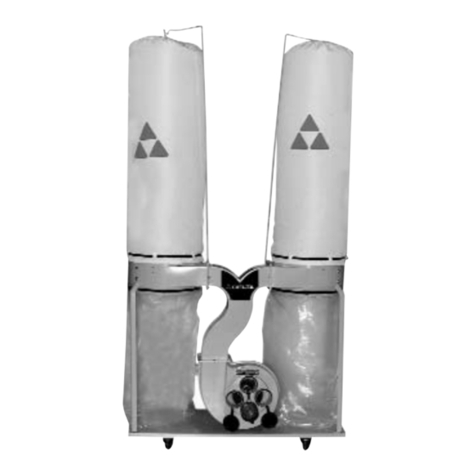
Delta
Delta 3 H.P. SINGLE-STAGE DUST COLLECTOR 50-852 User manual

Delta
Delta 50-762 User manual
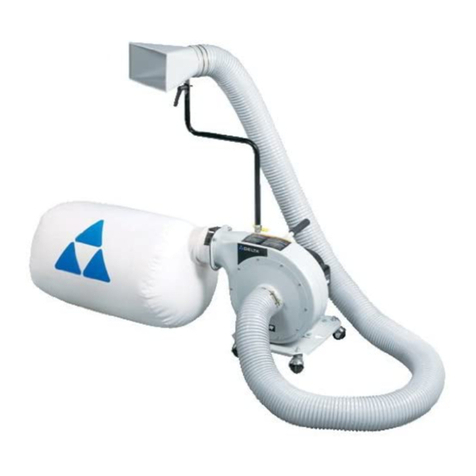
Delta
Delta A15098 User manual
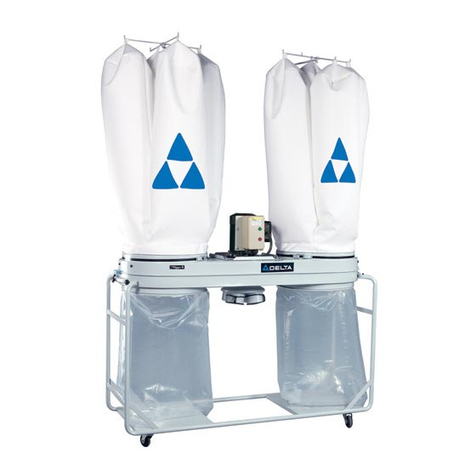
Delta
Delta 50-764 User manual
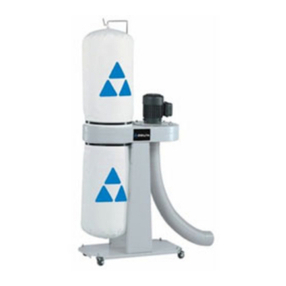
Delta
Delta AP400 User manual

Delta
Delta 50-820 User manual
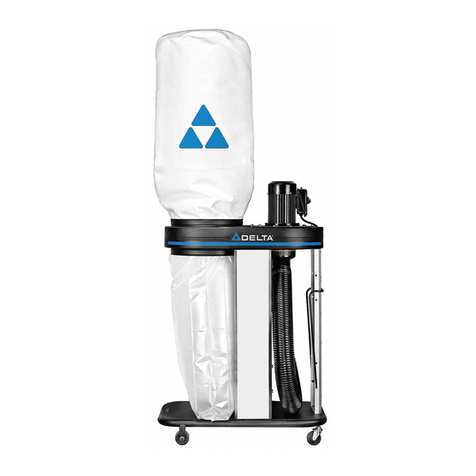
Delta
Delta 1-1/2 H.P. DUST COLLECTOR 50-786 User manual
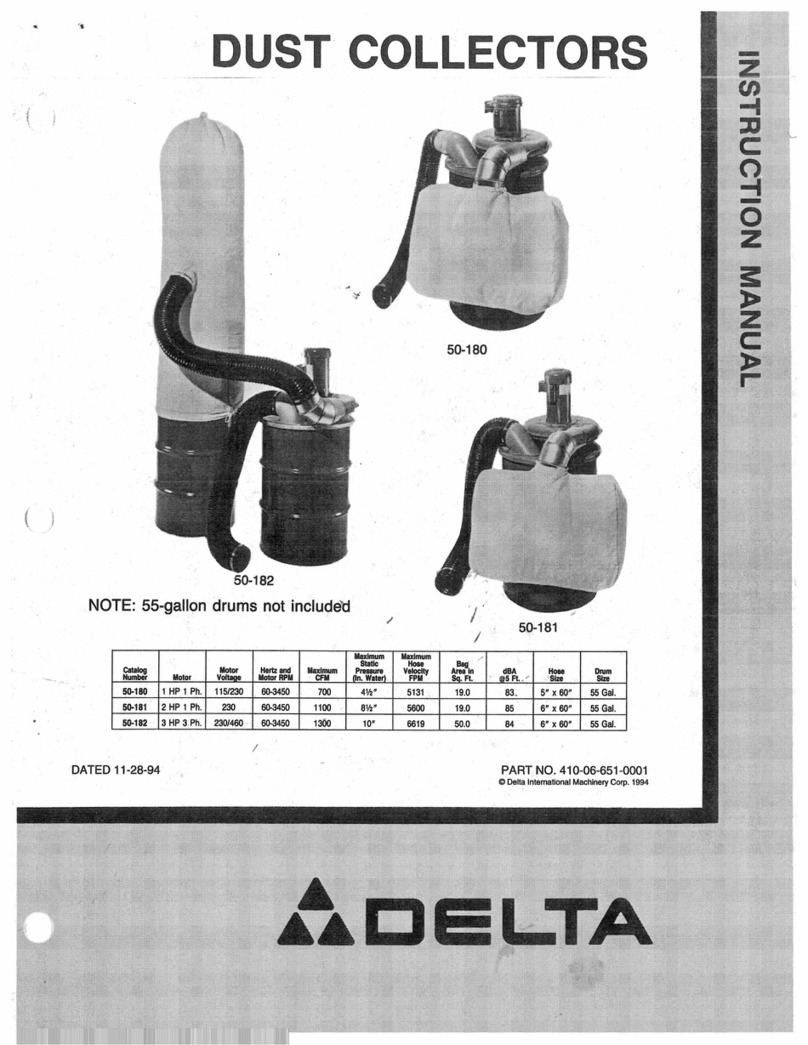
Delta
Delta 50-181 User manual
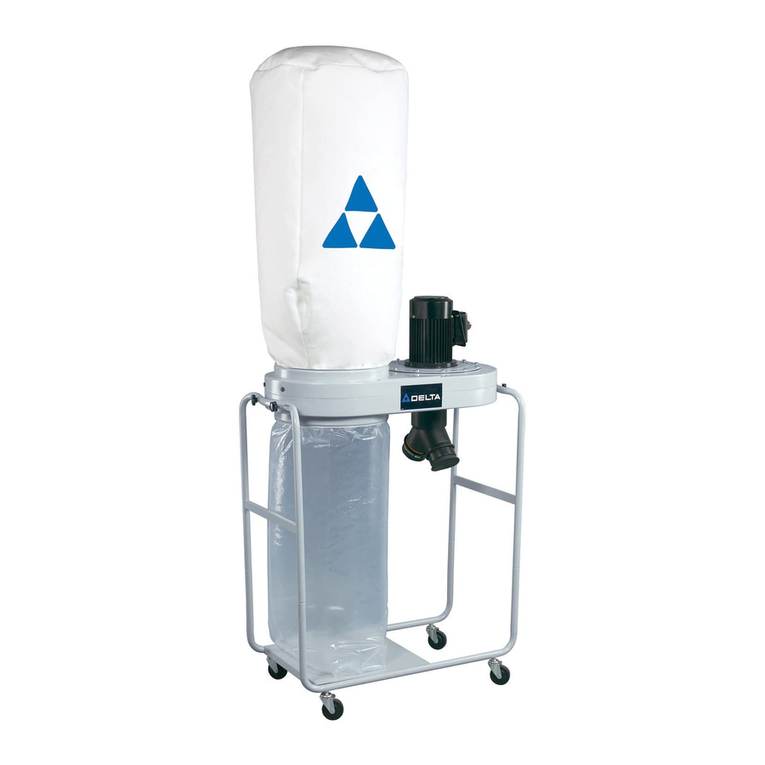
Delta
Delta 50-760 User manual

Delta
Delta 50-820 User manual
